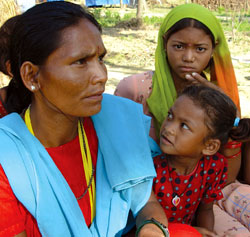|
|
Sushma Tharu, 14, and her parents never really stopped being enslaved. "Almost every day, most of us children go to sleep on an empty stomach," says Sushma, who had to quit school to get married as her parents simply couldn't afford to feed or clothe her any more.
Sushma is one of the over 100,000 former kamaiya Tharus 'liberated' six years ago when the government banned bonded labour. In the early 60s, thousands of Tharus were 'bonded' to high-caste landlords in southwest districts like Dang, Banke, Kailali, Bardiya, and Kanchanpur to work for free until they paid off all their family debts-usually all their lives.
Now, though free, they live in fear of new exploitative employers, hunger, and illness in the camps. Patu Tharu, 50, says that though he's happy to be free of his old master, he and his wife must survive on what grows on their tiny plot of government-issued land, and his wife must still work for employers, who work her for 18 hours a day and pay her Rs 300 a month.
"What freedom is this?" he asks bitterly. "There was no alternative for us but to fall into a similar trap as before. The hardship and exploitation continue for us," he adds.
There are a large number of kamaiya families like Patu's, resettled in makeshift huts in Banke and Bardiya districts. Their living conditions are squalid and they were relocated with little thought of what they would do later. Thousands of ex-kamaiya children can't go to school, as they must work to supplement their parents' livelihood. Most work long hours for little pay as construction workers, factory labour, domestic servants, cleaners, and porters.
"Ex-kamaiya children in particular are almost worse off now than they were before, and no one cares about their welfare," said Churna Bahadur Chaudhary, director of Backward Society Education (BASE) which, with rights group Insec, spearheaded the free kamaiya movement. Nearly 2,000 children of ex-kamaiyas work in exploitative conditions in Nepalganj alone.
Malnutrition, diarrhoea, and malaria are rampant, and there is no health post in the resettlement camps. When they finally get to a government health facility, many told us, they're simply doled out headache pills and told to go away.
Some organisations like Action Aid Nepal have been helping build low-cost houses for ex-kamaiyas and training them in income generating activities, but Chaudhary says that under a thousand families actually benefit from these efforts.
Hundreds of Tharu families marched to the capital in August and staged demonstrations to pressure the government to finally given them the land and livelihood support they are promised sporadically. But all they received, they say, were the same old empty promises.
"How long can we wait for the government to help us?" asks Ram Prasad Tharu who has been coming to the capital every year to meet ministers and government officials. He says he's always told to "be patient".
"We used to live in fear of our landlords in the past, now we worry that we'll have to sleep hungry another night," says 20-year-old Kali Tharu.



